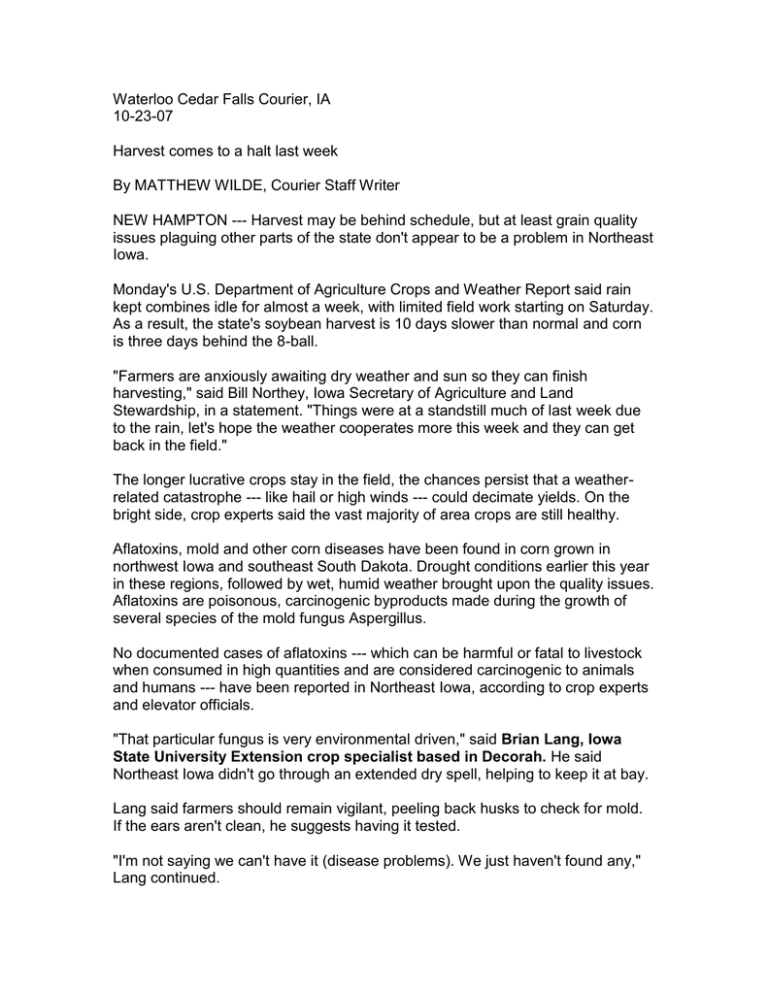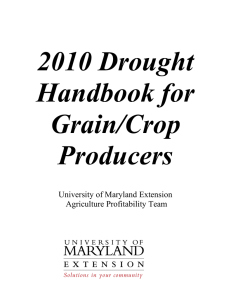Waterloo Cedar Falls Courier, IA 10-23-07
advertisement

Waterloo Cedar Falls Courier, IA 10-23-07 Harvest comes to a halt last week By MATTHEW WILDE, Courier Staff Writer NEW HAMPTON --- Harvest may be behind schedule, but at least grain quality issues plaguing other parts of the state don't appear to be a problem in Northeast Iowa. Monday's U.S. Department of Agriculture Crops and Weather Report said rain kept combines idle for almost a week, with limited field work starting on Saturday. As a result, the state's soybean harvest is 10 days slower than normal and corn is three days behind the 8-ball. "Farmers are anxiously awaiting dry weather and sun so they can finish harvesting," said Bill Northey, Iowa Secretary of Agriculture and Land Stewardship, in a statement. "Things were at a standstill much of last week due to the rain, let's hope the weather cooperates more this week and they can get back in the field." The longer lucrative crops stay in the field, the chances persist that a weatherrelated catastrophe --- like hail or high winds --- could decimate yields. On the bright side, crop experts said the vast majority of area crops are still healthy. Aflatoxins, mold and other corn diseases have been found in corn grown in northwest Iowa and southeast South Dakota. Drought conditions earlier this year in these regions, followed by wet, humid weather brought upon the quality issues. Aflatoxins are poisonous, carcinogenic byproducts made during the growth of several species of the mold fungus Aspergillus. No documented cases of aflatoxins --- which can be harmful or fatal to livestock when consumed in high quantities and are considered carcinogenic to animals and humans --- have been reported in Northeast Iowa, according to crop experts and elevator officials. "That particular fungus is very environmental driven," said Brian Lang, Iowa State University Extension crop specialist based in Decorah. He said Northeast Iowa didn't go through an extended dry spell, helping to keep it at bay. Lang said farmers should remain vigilant, peeling back husks to check for mold. If the ears aren't clean, he suggests having it tested. "I'm not saying we can't have it (disease problems). We just haven't found any," Lang continued. Some fusarium ear rot has been reported in the region, he said. Corn ears with scattered dark kernels are a typical sign. It's the most common fungal disease, but that doesn't necessarily mean grain is toxic. Judy Biwer, grain merchandiser at Five Star Cooperative locations in New Hampton, Ionia, Nashua, Lawler and North Washington, said the company is closely watching corn coming in. Any load that appears to have disease issues, a sample is taken and a black light is used to determine if mold exists. Damaged corn sharply reduces future storage life and makes good corn go out of condition if mixed. Buyers, like ethanol plants, will reject loads if the quality is poor. "Nothing has come in yet and hopefully nothing will. We check anything that even looks moldy," Biwer said. The crop report said some corn stalks are beginning to rot and there is volunteer sprouting in corn and soybeans fields. Grain movement was limited last week as well. The report said movement was 9 percent heavy, 24 percent moderate, 34 percent light and 33 percent none. With harvest lagging behind, grain storage isn't reaching critical mass yet. Offfarm storage is rated 17 percent short and 80 percent adequate, with a 3 percent surplus. On-farm storage is rated 27 percent short and 71 percent adequate, with a 2 percent surplus. Biwer said the weather-related break allowed Five Star's New Hampton location to free up more space for corn still in the field, shipping an undisclosed amount last week to processors. Still, the facility is already filling its 1.5 million bushel outdoor bunker knowing it won't take long to get to capacity of 2.9 million bushels once fields completely dry out. "We figured we're going to fill it anyway. I feel confident about that," Biwer said. Contact Matthew Wilde at (319) 291-1579 or matt.wilde@wcfcourier.com.



